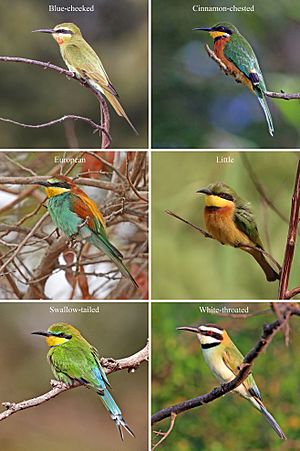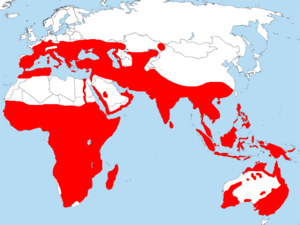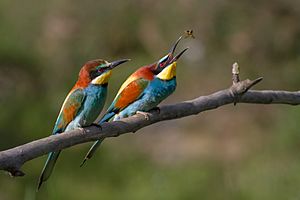Bee-eater facts for kids
Quick facts for kids Bee-eater |
|
|---|---|
 |
|
| Six common African bee-eaters | |
| Scientific classification |
|
| Kingdom: | Animalia |
| Phylum: | Chordata |
| Class: | Aves |
| Order: | Coraciiformes |
| Family: | Meropidae Rafinesque, 1815 |
| Genera | |
|
|
 |
|
| Approximate area where bee-eater species regularly breed | |
The bee-eaters are a group of colorful birds. They belong to the bird family called Meropidae.
These birds live in many parts of the world. You can find them in Africa, Asia, Europe, Australia, and New Guinea. They have bright feathers and slim bodies. Bee-eaters have long, curved bills and pointed wings. Their shape makes them look a bit like swallows. There are 26 different species of bee-eaters.
About Bee-eaters
What They Eat
As their name suggests, bee-eaters love to eat flying insects. Their favorite foods are bees and wasps. They catch these insects right out of the air. A bee-eater will dart from a perch to grab its prey. They only hunt insects that are flying. Once an insect lands, the bee-eater usually ignores it.
Most of their diet is made up of honeybees. Bees and wasps can make up a very large part of their meals. Before eating a bee or wasp, a bee-eater is very clever. It removes the sting! The bird does this by hitting and rubbing the insect on a hard surface. This action also squeezes out most of the venom.
Where They Live
Bee-eaters often live together in groups. They form colonies for nesting. They build their nests in burrows. These burrows are tunnels dug into the sides of sandy banks. You might find many of these holes close together. This often happens on the edges of rivers where the banks have collapsed.
Family Life
Most bee-eater species are monogamous. This means that one male and one female bird stay together. Both parents help care for their young. Sometimes, other birds from the colony even help out. This kind of helping behavior is quite unusual for birds.
Images for kids
-
Rainbow bee-eaters, a Merops species
-
Merops species like the white-fronted bee-eater often have a black bar through the eye.
-
The blue-bearded bee-eater lives in forests and hunts along the edges.
-
A male blue-throated bee-eater gives a captured insect to his mate.
-
A cliff where bee-eaters nest in Modi'in, Israel.
-
The southern carmine bee-eater is affected by hunting and loss of its home.
See also
 In Spanish: Abejarucos para niños
In Spanish: Abejarucos para niños










